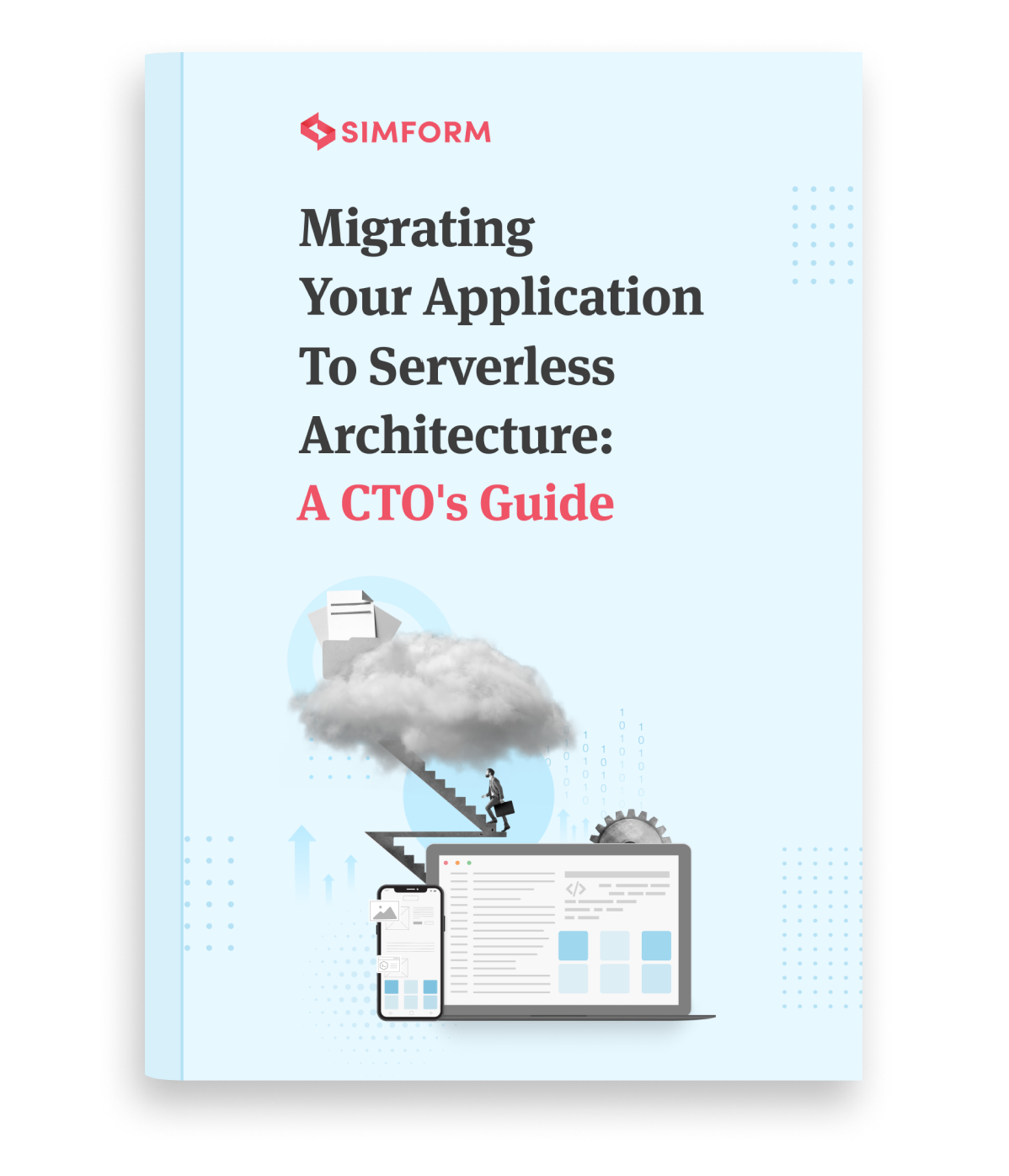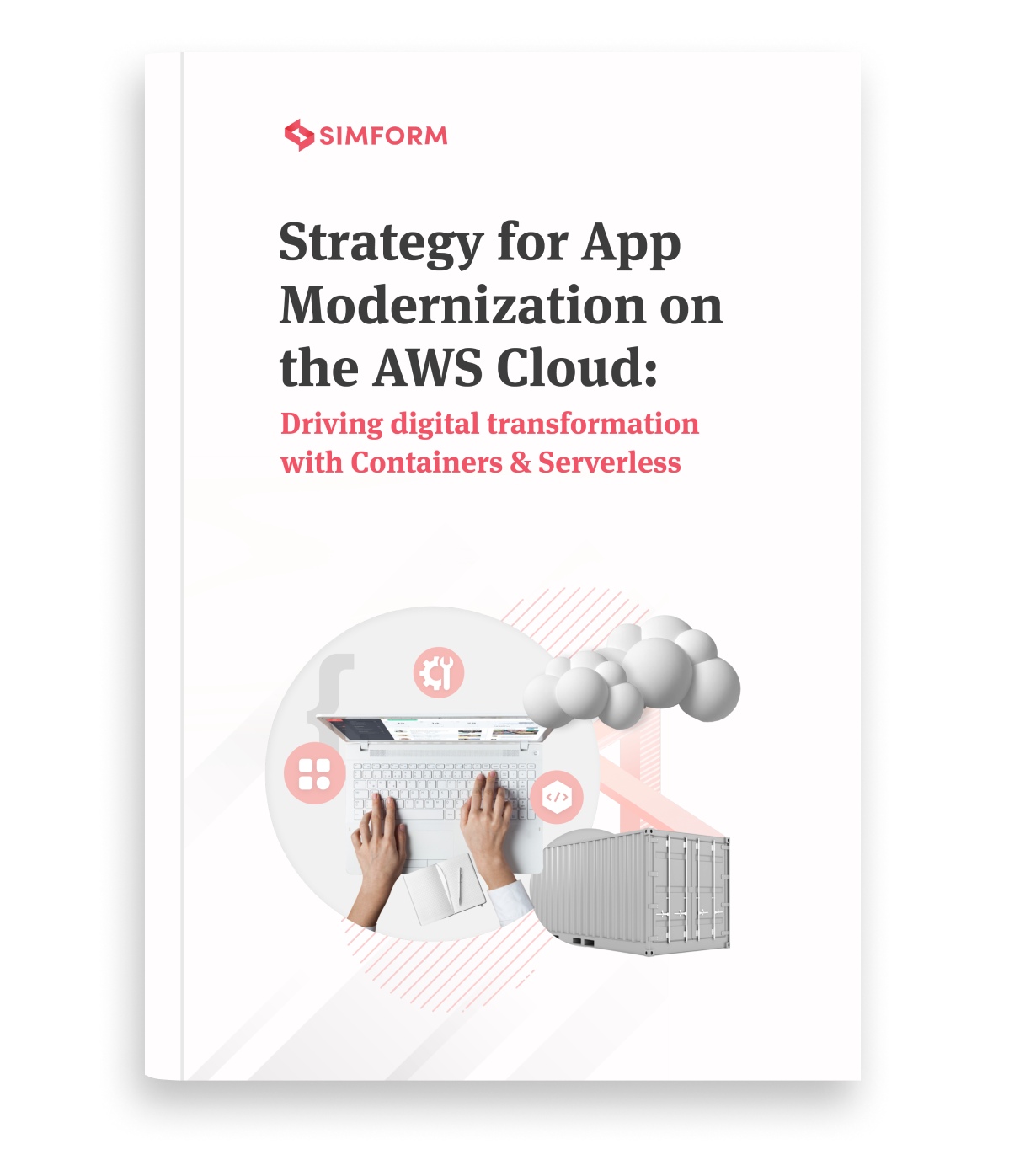Unpopular opinion: When designing and developing serverless applications, developers must reconsider their strategy.
Popular opinion: Enterprises have a growing need to upgrade their apps and methods for delivering digital experiences to millions of people. One such approach is serverless.
Tech executives are now rethinking their strategy in response to the desire to boost agility and lowering total operational overhead and costs. They had to reconsider how they could effectively, easily, and flawlessly design serverless.
AWS Lambda functions are stateless and ephemeral by design. And are the foundation of serverless applications created on AWS. Their operations are carried out on AWS-managed infrastructure. And this architecture can support and power a wide variety of application workflows.
All these factors urged us to reconsider how serverless applications should be designed. How to improve their dependability and reduce latencies? How to develop a durable platform for battling failures and enforcing security policies? All while not maintaining complex hardware.
This article introduces best practices for serverless apps to thrive in competitive markets. The practices are aligned with the carefully developed AWS’s well-architected framework.
So let’s begin!
6 Pillars of AWS Well-Architected Framework
The AWS Well-Architected Framework is a collection of principles. They focus on six major aspects of an application that significantly impact businesses.
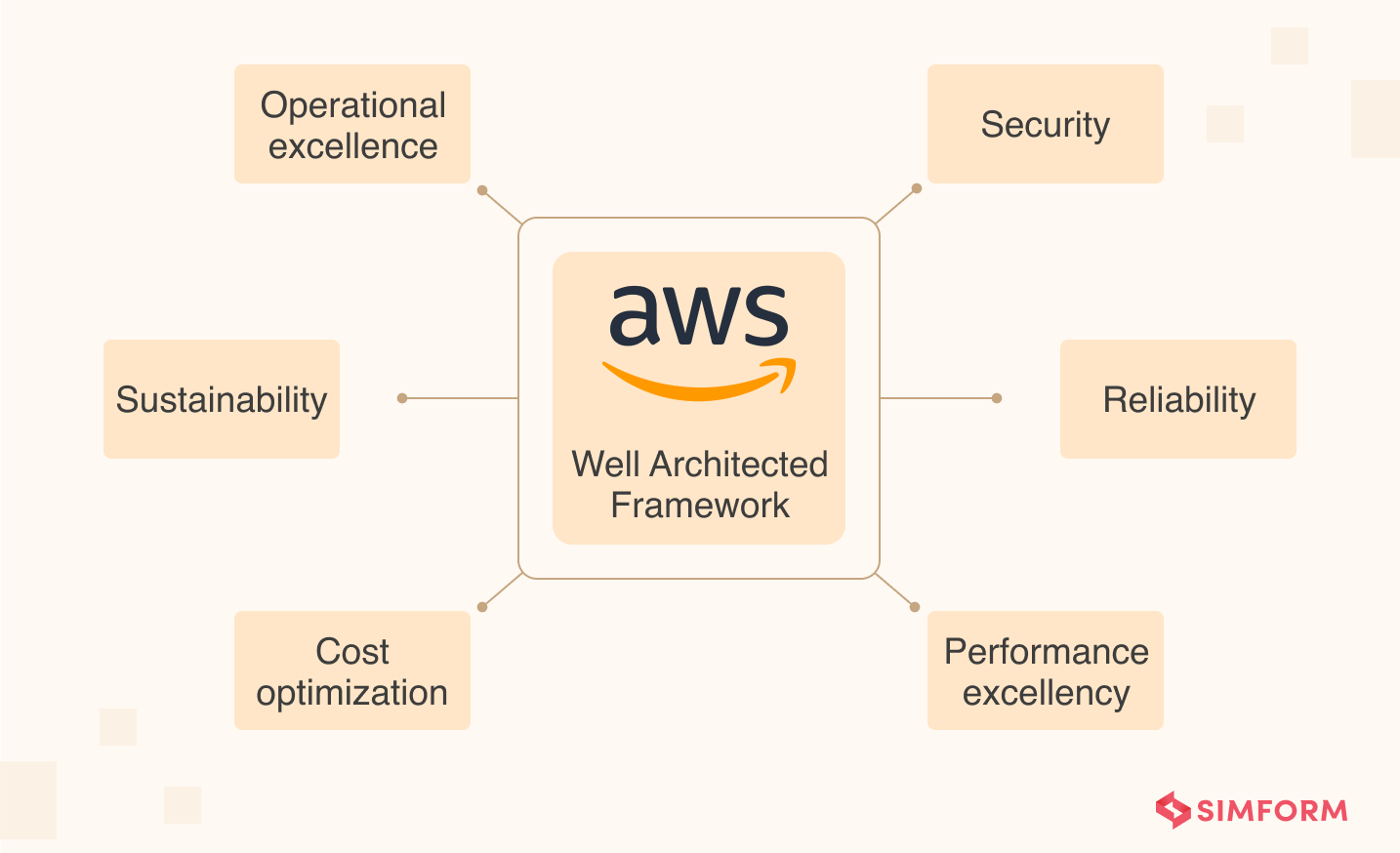
Operational Excellence:
To give the ability to support the development and run workloads effectively. In addition, to gain deeper insights into the operations. And continuously improve supporting processes to deliver business value.
Security:
To secure and protect data, systems, and assets. To make systems use the full potential of cloud technologies for improved security.
Reliability:
To ensure workloads perform their intended function correctly and consistently when expected to.
Performance:
To power workloads and applications to use the computing resources efficiently. To meet system requirements and maintain efficiency at peak levels as per the demand.
Cost optimization:
To ensure that the systems running deliver the business value at the lowest price point.
Sustainability:
To address the long-term environmental, economic, and societal impacts of your business. To guide businesses in designing applications, maximizing resource use, and establishing sustainability goals.
How to implement these pillars for your serverless application?
Security
Serverless apps are more vulnerable to security issues. Because these apps are based solely on Function as a Service (FaaS). And because third-party components and libraries are always connected via networks and events. As a result, exploiters can easily damage your application. Or embed it with vulnerable dependencies.
There are various methods that organizations may incorporate into their regular routines. They can address such difficulties and secure their serverless applications from possible threats.
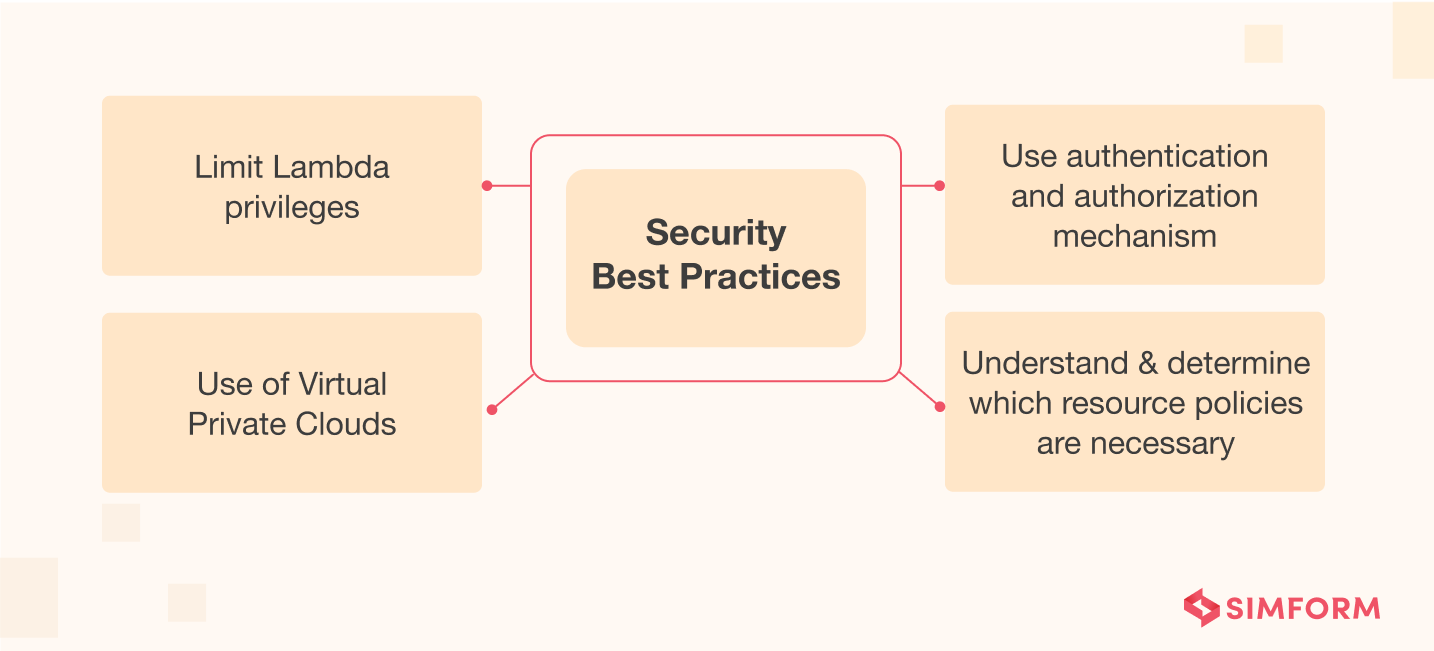
- Limit Lambda privileges
Let’s assume you’ve set up your serverless app on AWS. And you’re reducing costs and managing infrastructure with AWS Lambda functions. Using the principle of least privilege, you may reduce the danger of over-privileged Lambda functions. This principle gives IAM roles. This role gives you access to only the services and resources you need to complete the task.
For example, some tables, such as Amazon RDS, require CRUD permission. While some tables need read-only permission. As a result, these policies limit the scope of authorization to specific actions. Securing serverless apps is simple if you grant different IAM roles to each Lambda function. And each with its own set of permissions.
- Use of Virtual Private Clouds
With Amazon Virtual Private Clouds, you can deploy AWS resources within a customized virtual network. It includes many capabilities for safeguarding your serverless application. For example, configuring virtual firewalls with security groups for traffic control to and from relational databases and EC2 instances. Using VPCs, you can also significantly decrease the number of exploitable entry points and loopholes. These loopholes & entry points can expose your serverless application to security threats.
- Understand and determine which resource policies are necessary
Resource-based restrictions can be implemented to secure services with somewhat limited access. These policies can safeguard service components by specifying actions and access roles. Utilize them per several identities like source IP address, version, or function event source. Before any AWS service implements authentication, these policies are assessed at the IAM level.
- Use an authentication and authorization mechanism
Use authentication and authorization techniques to regulate and manage access to specific resources. A well-designed framework suggests using this mechanism for serverless APIs in serverless applications. When used, these security measures confirm a client’s and a user’s identity. It determines if they have access to a specific resource. This method makes it simple to stop unauthorized users from interfering with service.
For more information on how to address specific security concerns with serverless apps, check out this detailed guide on serverless security.
Operational Excellence
“OpEx is one of the highest ROI’s that you will ever experience.”
- Use application, business, and operations metrics
Identify key performance indicators, including business, customer, and operations outcomes. And you will quickly get a higher-level picture of an application’s performance
Evaluate your application performance in relation to the business objectives. For instance, consider an eCommerce business owner. He might be interested in learning the KPIs linked to customer experience. It helps emphasize the overall effectiveness of how users are utilizing the app, if you notice less transactions in your eCommerce application. It also includes perceived latency, duration of the checkout process, ease of choosing a payment method, etc.
These operational indicators enable you to monitor your application’s operational stability over time. You may maintain the stability of your app using a variety of operational KPIs. They can be continuous integration, delivery, feedback time, resolution time, etc.
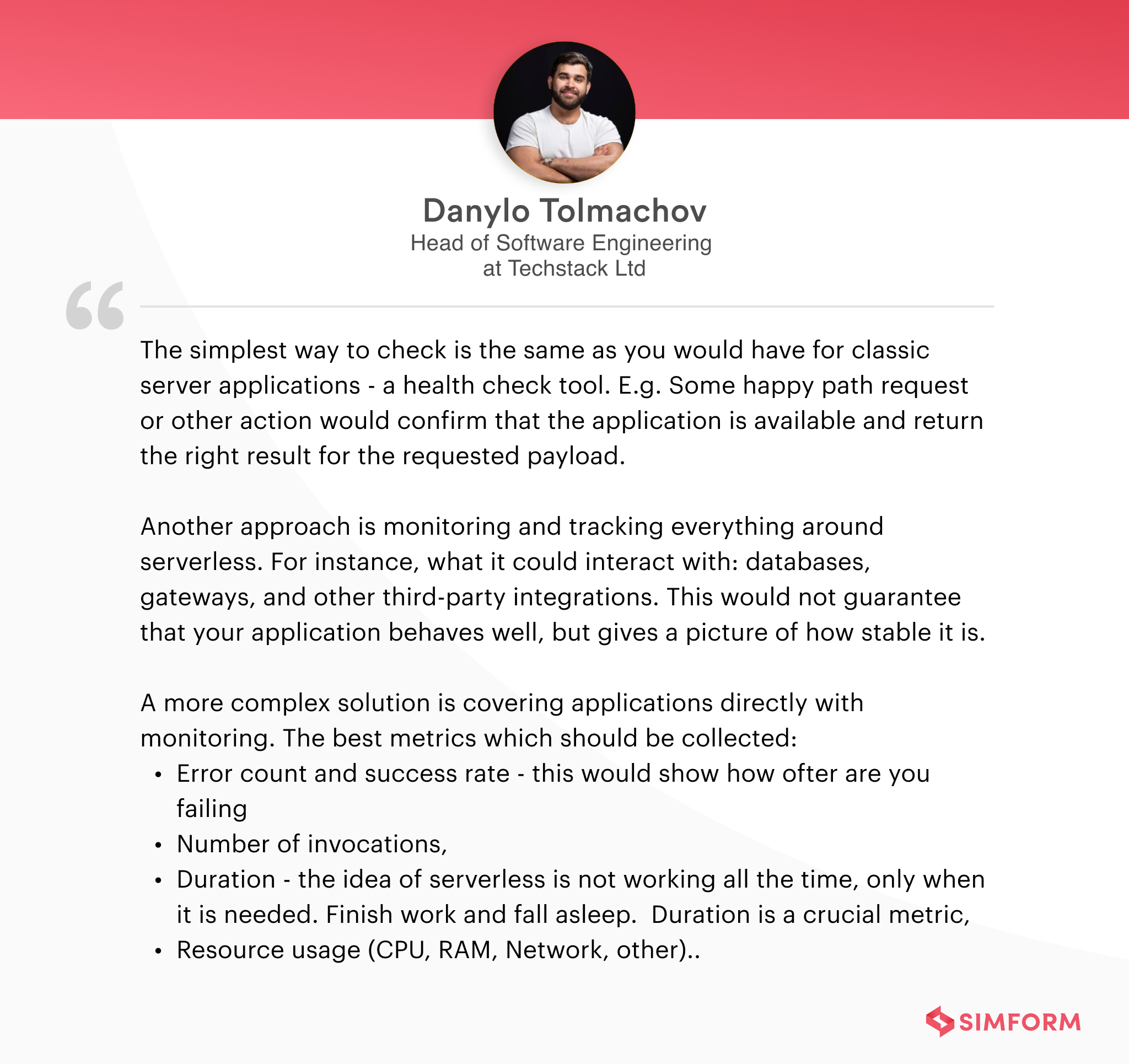
- Understand, analyze, and alert on metrics provided out of the box
Investigate and analyze the behavior of the AWS services that your application uses. AWS services, for instance, offer a set of common metrics right out of the box. The metrics assist you in tracking the performance of your applications. These metrics are generated automatically by services. You only need to start tracking your application and set up your own unique metrics.
Determine which AWS services your application utilizes. For example, consider an airline reservations system. It uses AWS Lambda, AWS Step Functions, and Amazon DynamoDB. Now, these AWS services reveal metrics to Amazon CloudWatch when a customer requests a booking. It does so without affecting the application’s performance.
Reliability
- High availability and managing failures
Systems have a significant chance of getting periodic failures. The chances are higher when one server depends on another. Although the systems or services don’t completely fail, they occasionally suffer partial failures. So applications must be designed sustainably to handle such component failures. The application architecture should be capable of both fault detection and self-healing.
For instance, transaction failures might happen when one or more components are unavailable. Or when there is a lot of traffic. And AWS Lambda is built to handle faults and is fault tolerant. If the service encounters any difficulty calling a certain service or function, it invokes the function in a different Availability Zone.
Amazon Kinesis and Amazon DynamoDB data streams are another illustration for understanding reliability. Lambda makes several attempts to read the complete batch of objects while reading from these two data sources. Until the records expire or reach the maximum age that you define on the event source mapping, these retries are made again. A failed batch can be split into two batches using event sourcing in this arrangement. Smaller batch retries isolate corrupt records and get around timeout problems.
When non-atomic actions occur, it’s a good idea to evaluate the response and deal with partial failures programmatically. For example, if at least one record is successfully ingested. Then, PutRecords for Kinesis and BatchWriteItem for DynamoDB returns a successful result.
- Throttling
This method can be used to prevent APIs from receiving an excessive number of requests. For instance, Amazon API Gateway throttles calls to your API. It restricts the number of queries a client may submit within a specific time frame. All clients employing the token bucket algorithm are subject to these restrictions. Both the steady-state rate and the burst of requests submitted are constrained by API Gateway.
A token is taken out of the bucket with each API request. The quantity of concurrent requests is determined by throttle bursting. By restricting excessive use of API, this strategy maintains system performance and minimizes system degradation. For instance, consider a large-scale, global system that has millions of users. It receives a significant volume of API calls every second. And it’s crucial to handle all these API queries that can cause the systems to lag and perform poorly.
Performance Excellency
- Reduce cold starts
Less than 0.25 percent of AWS Lambda requests are cold starts. Yet, they have a significant impact on application performance. The code execution can occasionally take 5 seconds. However, it occurs more frequently in big, real-time applications that operate and need to be executed in milliseconds.
Reducing the amount of cold starts is advised by AWS’s well-architected best practices for performance. By considering a variety of factors, you can do this. For instance, how quickly your instances start. It depends on the languages and frameworks you use. For example, compiled languages launch more quickly than interpreted ones. Programming languages like Go and Python, for instance, are quicker than Java and C#.
As an alternative, you should aim for fewer functions that enable functional separation. Finally, it makes sense to import the libraries and dependencies required for processing application code. You can import specific services rather than the complete AWS SDK. For instance, if your AWS SDK includes Amazon DynamoDB, you can import Amazon DynamoDB.
- Integrate with managed services directly over functions
Using native integrations among managed services is good. Instead of using Lambda functions when no custom logic or data transformation is required. Native integrations help achieve optimal performance with minimum resources to manage.
For example, take Amazon API Gateway. With it, you can natively use the AWS integration type to connect to other AWS services. Likewise, when using AWS AppSync, you can use VTL, direct integration with Amazon Aurora, and Amazon OpenSearch Service.
The serverless architecture is gaining popularity in the tech industry as it helps to reduce the operational cost and complexity. Many experienced tech individuals have shared their insights on the best practices of serverless application development. Here are the top 3 insights from a technocrat:
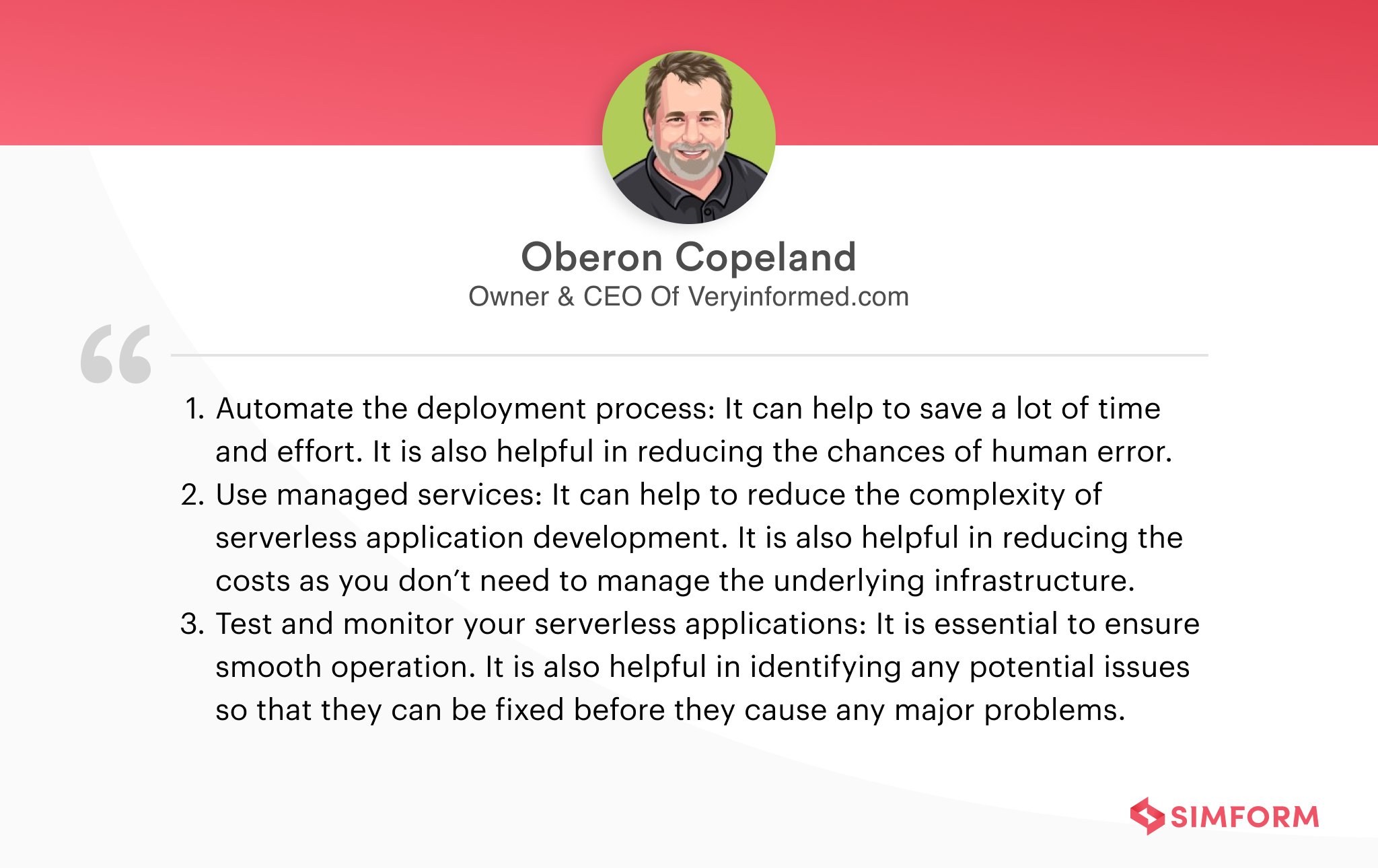
Let’s look into Natura’s example to know how AWS’s well-architected framework benefits businesses.
The Natura brand, a division of Natura & Co., is the fourth-largest cosmetics company in the world. It aimed to provide its clients a unique purchasing experience. So they needed to establish and streamline interactions with their consultants. And do it in a way that promoted personalized digital experiences as they were spread out across 70 countries.
Due to the company’s recent launch of a new sales platform, it was difficult to arrange a full-stack deployment to Peru. At the same time, that country was receiving all integrated platforms. They were in a very competitive market, and the new platform had a lot to offer in terms of capabilities.
The first implementation encountered difficulties from a number of angles, including:
- High functional range
- Business logic aggregations due to integration between components from various sales platforms
- Goals of the beauty consultant
- Indicators analysis and reliability of the most important indicators.
The cosmetics giant improved user experience after implementing suggestions from AWS’s well-architected framework. It also improved its application performance index, which went from 0.78 to 0.96. Additionally, it improved the platform’s resilience and reduced its sensitivity to unexpected failures.
To better fine-tune the performance of your serverless apps, read this blog post on AWS Lambda performance best practices.
Cost Optimization
- Required practice: Minimize external calls and function code initialization
Understanding the importance of initializing a function is crucial. Because when a function is called, all its dependencies are also imported. Each library you include slows down your application if it uses multiple libraries. It’s crucial to minimize external calls and remove dependencies wherever feasible. Because it is impossible to avoid them for operations like ML and other complicated functionalities.
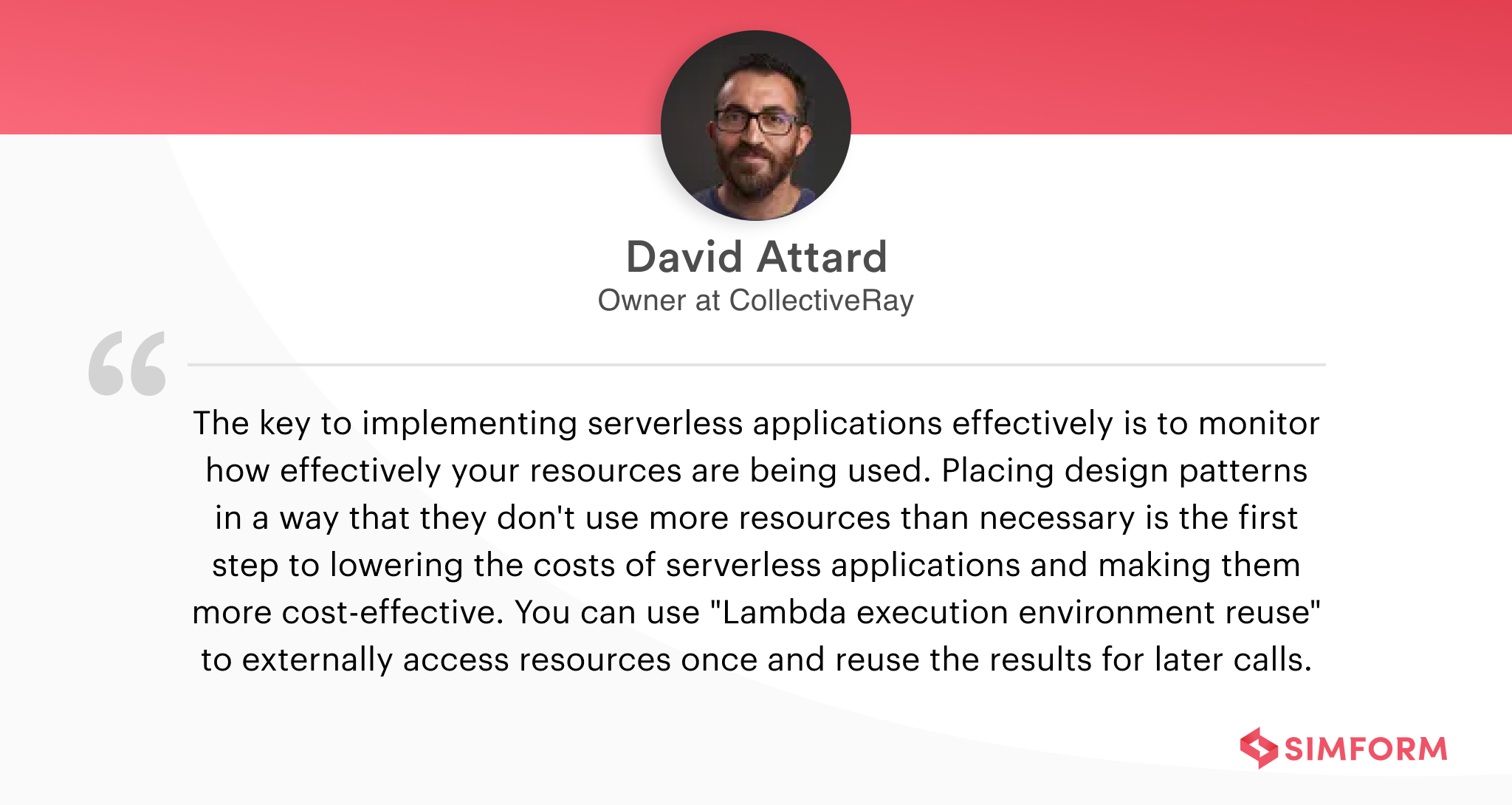
Recognize and limit the resources that your AWS Lambda functions access while in use. It may have an immediate effect on the value offered per invocation. Thus, it’s critical to lessen dependence on other managed services and third-party APIs. Functions can occasionally leverage application dependencies. But it may not be appropriate for ephemeral environments.
To give you a better idea:
Hannon Hill, the creator of Cascade CMS, was assisted by one of AWS’s partners. It did a well-architected framework evaluation to ensure its environment was properly built. And to see if there were any further possibilities for cost optimization.
Maintaining the security posture was the company’s top priority. But they found more than 120 EC2 instances without a connected IAM profile. And found S3 buckets without default encryption.
Additionally, there were some idle EC2 instances, EBS volumes attached to paused EC2 instances, and expired Reserved Instances.
Following the remediation phase, the business could implement cloud storage policies. And take advantage of cost-optimization best practices, EC2 right sizing, and optimize idle resources that were connected to halted instances.
They also implemented a multi-AZ solution with application load balancing between two AZs. It helped improve the availability and dependability for mission-critical applications.
- Review code initialization
The time AWS Lambda takes to initialize application code is reported by AWS Lambda in Amazon CloudWatch Logs. You should use these metrics to track prices and performance. Because Lambda functions bill is based on the number of requests made and the amount of time spent.
Improve the overall execution time by reviewing your application’s code and its dependencies. Additionally, you can make calls to resources outside of the Lambda execution environment and use the responses for subsequent invocations. We also advise employing TTL mechanisms within your function handler code in specific circumstances. This method makes it possible to preemptively collect data that is unstable without having to make additional external calls, which would add to the execution time.
Read more about proven best practices for cloud cost optimization
Sustainability
The last and newly introduced AWS’s well-architected sixth pillar is about sustainability. But, like other pillars, it also contains questions that evaluate your workloads. It evaluates the design, architecture, and implementation, keeping energy consumption and improving efficiency.
AWS customers can reduce associated energy usage by nearly 80% concerning typical on-premises deployment. It is because of the capabilities AWS offers its customers to achieve higher server utilization, power, and cooling efficiency, custom data center design, and continuous efforts to power AWS operations with 100% renewable energy by 2025.
Sustainability for AWS means facilitating certain design principles while you design your application on the cloud:
- It is to understand and measure business outcomes and related sustainability impact. And to establish performance indicators and evaluate improvements.
- AWS emphasizes and allows to right-size each workload to maximize energy efficiency.
- It recommends setting long-term goals for each workload. Model ROI and design an architecture to reduce impact per unit of work. For example, per-user or operation, to achieve sustainability at granular levels.
- AWS recommends continuously evaluating your hardware and software choices for efficiency and design for flexibility and choosing flexible technologies over time.
- Use shared, managed services to reduce the infrastructure needed to sustain a broader range of workloads.
- Reduce the resources or energy needed to use your services. And lessen the need for your consumers to upgrade their devices.
Benefits of the AWS Well-Architected Framework
The AWS Well-Architected Framework offers a range of benefits for businesses leveraging Amazon Web Services (AWS). From reducing risk to increasing efficiency, this framework provides valuable advantages. Let’s explore the key benefits in brief.
1. Enables faster builds and deployments
The AWS Well-Architected Framework streamlines processes and procedures through which businesses can enhance operational efficiency, leading to accelerated application development and deployment. This results in a shorter time-to-market and the ability to scale the system with minimal risk.
2. Encourages a cloud-native approach
The WAF is a cloud-native approach, meaning it focuses on leveraging the advantages of cloud computing from the outset. This results in high-performing applications designed to take full advantage of the cloud environment. Moreover, these applications can be built and deployed quickly, easily adapted to different environments, and scaled to meet customer demand.
3. Helps mitigate risks
Regular reviews of the Well-Architected Framework allow you to proactively identify and address potential risks and issues before they become problematic. This enables you to assess critical workloads and quickly resolve problems as they arise, ensuring the reliability and stability of your systems.
4. Establishes consistency
When a framework is adopted throughout the organization, you establish a consistent approach to building reliable and scalable infrastructure. This consistency is valuable when roles change within the organization or new employees join, as it ensures everyone is aligned and working towards the same goals.
5. Gives insight into the potential impact of changes
In agile and constantly evolving cloud environments, applications are developed, updated, and deployed often and rapidly. And with such frequent changes, there is always the possibility of a negative or positive impact on the system and infrastructure. The WAF enables you to assess and address potential impact before implementing changes.
6. Facilitates continuous improvement
The Well-Architected Framework provides a means to measure your systems against best practices and identify areas for improvement. Regular reviews promote continuous improvement, resulting in better product quality, increased customer satisfaction, and a stronger sense of teamwork and product ownership.
Reasons for choosing AWS Architectural frameworks
Organizations choose AWS architectural frameworks mainly because they provide a structured approach to designing and building systems in AWS. Here are several other reasons why organizations choose the Well-Architected Framework:
- Helps understand architectural best practices:
It helps you learn the best practices for designing and operating secure, reliable, efficient, cost-effective, and sustainable workloads on AWS.
- Offers expert guidance:
AWS Solutions Architects with extensive experience across various industries and use cases have contributed to the framework. And using their contributions, the framework offers valuable insights and strategies for architecting systems in the cloud.
- Ensures alignment with cloud best practices:
The framework includes a set of foundational questions that help you assess if your architecture aligns well with cloud best practices. These questions help you ensure that your systems meet the expected qualities of modern cloud-based solutions.
- Continuously refines itself:
AWS continues to refine the definition of well-architected based on ongoing learnings from working with customers. As a result, the framework remains up-to-date and relevant in the evolving cloud landscape.
- Helps build a strong foundation:
By following AWS Architectural Frameworks, you can build a solid foundation for your cloud infrastructure, enabling you to leverage the full potential of AWS services and maximize the value of your investment.
- Enhances decision-making:
The framework helps you make informed architectural decisions, understanding the trade-offs and potential risks involved. This helps you make better-informed decisions.
- Facilitates industry recognition:
Following AWS Architectural Frameworks demonstrates your commitment to industry-recognized best practices and standards. This enhances your credibility and positioning in the market.
- Rapid adaptation to change:
Cloud-native approaches supported by the framework allow for rapid adaptation to changing business requirements and market conditions, enabling faster build and deployment times and scalability to meet customer demands.
Overall, a well-architected system significantly increases the likelihood of business success by providing secure, high-performance, reliable, and efficient cloud infrastructures. Moreover, it encourages a culture of continuous improvement, fostering better product quality, increased customer satisfaction, and improved collaboration and ownership among teams.
Six Pillars, one review!
This blog introduced best practices to follow AWS Well-Architected Framework for serverless applications. We also saw some examples that make it look effortless to follow the framework.
But what when you want to know whether your existing applications and workloads are correctly placed? Or are they following the best practices (or some of them) post the remediation stage? Then, it’s a good idea to connect with seasoned AWS professionals. And once your application is scanned for the well-architected review, you’ll have a step-by-step roadmap. It will suggest how to optimize costs, performance, operational excellence, and other aspects your business prioritizes the most!
Simform has helped many customers assess mission-critical applications for the well-architected framework. We’re an AWS Premier Consulting Partner. And we have helped customers build serverless applications in a well-architected way. Our AWS-certified experts love to build, assist, and deploy serverless apps using AWS-recommended best practices. If you’re looking for a similar experience, reach out to us today!
